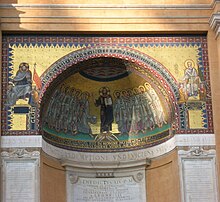Lateran Palace: Difference between revisions
HotCat |
Rescuing 1 sources and tagging 0 as dead. #IABot (v1.6.1) (Balon Greyjoy) |
||
| Line 68: | Line 68: | ||
== Notes == |
== Notes == |
||
{{Reflist|group=Notes|60em|refs= |
{{Reflist|group=Notes|60em|refs= |
||
<ref name=Notes1>The basilica and the palace, which are owned by the [[Holy See]] (article 13 of the [http://www.vaticanstate.va/NR/rdonlyres/3F574885-EAD5-47E9-A547-C3717005E861/2528/LateranTreaty.pdf Lateran Treaty),] "form(s) part of the territory of the Italian State (but) enjoy(s) the immunities granted by International Law to the headquarters of the diplomatic agents of foreign States" (article 15 of the Lateran Treaty).</ref> |
<ref name=Notes1>The basilica and the palace, which are owned by the [[Holy See]] (article 13 of the [http://www.vaticanstate.va/NR/rdonlyres/3F574885-EAD5-47E9-A547-C3717005E861/2528/LateranTreaty.pdf Lateran Treaty),] {{webarchive|url=https://web.archive.org/web/20110813090725/http://www.vaticanstate.va/NR/rdonlyres/3F574885-EAD5-47E9-A547-C3717005E861/2528/LateranTreaty.pdf |date=2011-08-13 }} "form(s) part of the territory of the Italian State (but) enjoy(s) the immunities granted by International Law to the headquarters of the diplomatic agents of foreign States" (article 15 of the Lateran Treaty).</ref> |
||
<ref name=Notes2>Geographic location: {{coord|25|43|7.46|N|32|39|26.64|E|region:EG_type:landmark|name=Lateranense_Karnak}}</ref> |
<ref name=Notes2>Geographic location: {{coord|25|43|7.46|N|32|39|26.64|E|region:EG_type:landmark|name=Lateranense_Karnak}}</ref> |
||
}} |
}} |
||
Revision as of 03:55, 1 December 2017
The Lateran Palace (
Located on St. John's Square in Lateran on the
Following the Lateran Treaty of 1929, the palace and adjoining basilica are extraterritorial properties of the Holy See.[Notes 1]
History
Pre-papal use
The site on which the Basilica di San Giovanni in Laterano sits was occupied during the early
Constantinian era
The Domus Laterani fell into the hands of the emperor when
Subsequent renovations

As Byzantium grew less able to help prevent Lombard incursions, the papacy became more independent of the Empire.
Author Erik Thunø notes that the incentive to refurbish the Lateran Palace was to create an imperial residence from which the pope could exercise not only spiritual but also temporal authority.
The Triclinium and the sala del concilio, an oblong hall with apse mosaic and five ornate niches on each side, were built around 800 to serve as the heart of papal ceremonial. Architecturally they were reminiscent of Byzantine imperial buildings in Constantinople.[3]
In the tenth Century
Between this palace and the Lateran basilica was the
In its place, the
The whole of the front of the palace was taken up with the Aula Concilii ("Hall of the Council"), a magnificent hall with eleven apses, in which were held the various
Avignon Papacy

The fall of the palace from this position of glory was the result of the departure of the popes from Rome during the Avignon Papacy.
Two destructive fires, in 1307 and 1361, did irreparable harm, and although vast sums were sent from Avignon for the rebuilding, the palace never again attained its former splendour. The palace had Gothic architectural elements at this point. When the popes returned to Rome they resided first at
16th-century alterations
The architect he employed, immediately upon his election, was Domenico Fontana, who was engaged in alterations to the basilica at the same time. Fontana's strong, restrained style, was influenced by Giacomo Vignola and modeled upon Palazzo Farnese for its regular and harmonious if somewhat bland major façade. Fontana's sound engineering basis and power of coordinating a complicated architectural program on a tightly constrained site, which Sixtus urged forward at top speed, have been considered remarkable.[4]
A notice on 29 August 1589 announced that the work had been completed: "A great palace in Piazza Lateranese has been brought to completion by Sixtus V."
From the old Lateran constructions three monuments survive, two of which are located in one building built by
Modern use
The Lateran remained in a suburban environment, surrounded by gardens and vineyards, until the growth of modern Rome in the later nineteenth century. Its site was considered unhealthy in Rome's
In 1925
During the Second World War, the Lateran and its related buildings provided a safe haven from the Nazis and Italian Fascists for numbers of Jews and other refugees. Among those who found shelter there were
Fathers Vincenzo Fagiolo and Pietro Palazzini, vice-rector of the seminary, were recognized by Yad Vashem for their efforts to assist Jews.[6][7]
Seat of the Vicariate of Rome
On 27 July 1992, a bomb explosion devastated the facade of the Rome Vicariate at St. John Lateran. The attack is widely assumed to have been the work of the
As for the present pastoral functions of the palace, it today houses the offices of the Vicariate of Rome, as well as the living quarters of the Cardinal Vicar General of His Holiness for the Diocese of Rome.
Tourists can visit the papal apartments, usually in the morning.
See also
- Index of Vatican City-related articles
Notes
- ^ a b The basilica and the palace, which are owned by the Holy See (article 13 of the Lateran Treaty), Archived 2011-08-13 at the Wayback Machine "form(s) part of the territory of the Italian State (but) enjoy(s) the immunities granted by International Law to the headquarters of the diplomatic agents of foreign States" (article 15 of the Lateran Treaty).
- ^ Geographic location: 25°43′7.46″N 32°39′26.64″E / 25.7187389°N 32.6574000°E
References
- ^ a b Barnes, Arthur. "Saint John Lateran." The Catholic Encyclopedia. Vol. 9. New York: Robert Appleton Company, 1910. 16 Jul. 2014
- ^ a b c Hager, June. "Churches of Rome: Christianity's First Cathedral", Inside the Vatican, February 1996
- ^ a b c Thunø, Erik. Image and Relic: Mediating the Sacred in Early Medieval Rome, L'Erma di Bretschneider, 2002
- ^ a b Ludwig von Pastor, History of the Popes From the Close of the Middle Ages, vol. X p 616.
- ISBN 9780809140329
- ^ "Palazzini", the righteous among the Nations, Yad Vashem
- ^ "Fagiolo", The Righteous Among the Nations, Yad Vashem
External links
![]() Media related to Lateran Palace at Wikimedia Commons
Media related to Lateran Palace at Wikimedia Commons
- Official site (in Italian)
- palace - map of piazza and plates (engravings)
